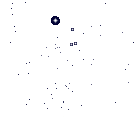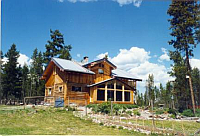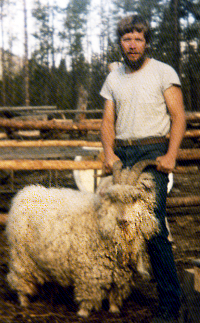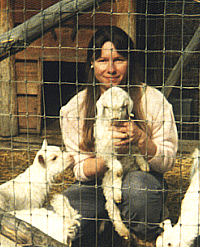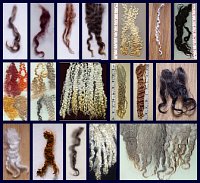Angora Goats ~ Mohair ~ And Us
Why mohair? I mean, who knows anything about mohair? As soon as you mention angora goats most people think of "angora". Heh! When I say that mohair comes from angora goats and "angora" comes from angora rabbits they say "Oh" but I still don't think many catch the distinction. Fewer still realize that the word "angora" is actually a mutation of the word Ankara, the capital city of Turkey. Out side of Texas (once the third highest mohair producer in the world) little is known of mohair in the USA today. Fortunately the internet has many valuable and informative pages on the subject. Hopefully we will be able to link from here to there as time goes on. If you come across a valuable resource on the internet with information concerning angora goats or mohair please feel free to send the internet address to us and we will post it after looking it over. In the mean time let me indulge your fancy with some anecdotal and very subjective information on why we love this fiber and how we "got into it".
This will be dating Alexandra and I, but fact is that we are part of a rare breed of the baby boomers who are called "Back to the Landers". From the mid 1960's to the mid 1970's there was a migration of a certain element of our society back to farms and forests. By far most of these individuals didn't remain a part of this grand experiment to rediscover nature and to live in harmony with it. The main reason for this is that the life style can be very very hard. America is no longer based on a rural agricultural society. Communities are no longer tight knit mutually supportive repositories of knowledge and skill that are learned through experience. The wisdom of generations past is all but out of reach to the new farmer.
After going through a period of readjustment in our thinking and casting away any semblance fear Alexandra and I settled in the Colorado Rocky Mountains. We spent a few years working hard and accumulating knowledge and experience through reading, doing and devouring the Mother Earth News magazine for continued inspiration. For us, for a lot of reasons, there was no turning back. Ten years of fasting, granola and getting close to nature convinced us we needed to do or die. We believed it was a better way.
Goats have played a vital role in our survival. We started out with dairy goats. Learning to milk goats, make cheese, yogurt and whipped cream was exciting. Learning to utilize the by-products of these processes to nourish our livestock keep was a major milestone of achievement for us. What ever would someone being from inner city Philadelphia have to do with goats?
In 1981 we made a major move from the high climbs of the Colorado Rockies to the Northern Mountains of the Montana-British Columbia border. We lived off the grid for ten years and it was there that goats became a mainstay for us.
As we go along click on the thumbnail images if you want a larger view.
Our Mainstay
It was an early and hard lesson for us. The only way to succeed in our venture was to be as efficient as possible. One of those initial acts of efficiency was to replace our alpine dairy breed buck. His sole purpose was to "freshen" (breed) the dairy goat does once a year. "Rocky" the buck was a large fellow with a large appetite that terrorized my wife and regularly caused damage to the goat barn. He had a free lunch all year around for his one single purpose.
Our early acquisitions included a spinning wheel and loom. We surmised that we could double up the bucks job by growing mohair while we waited for the annual Autumnal fertility rites. We spent a considerable amount of time (months) and effort trying to find someone within a reasonable distance of our remote location who could supply us with a good healthy fiber producing buck.
Lo and behold not two hours drive away was a very sweet lady who raised very high quality angora goats. Karen was as surprised as we to find a "local" enthusiast. The short of it was that we purchased her entire herd! She was getting along in years and couldn't devote the time in intensive shepherding practices these creatures require.
What fantastic creatures they were. Gloriously arrayed in living radiant fiber. They seemed to emerge out of a fairy tale. How shocked we were to see that their personalities were so much more mellow than the dairy breeds. (Within reason of course - goats are always capricious).
Thus we began a crash course in angora goat husbandry. Interpret that to mean we learned the hard way. Alas, the gracious creatures were forgiving of our novice efforts. They are definitely not as hardy as the dairy breeds. Most of the energy they employ is devoted to growing mohair. For centuries they were bred in the ancient steeps of Turkey. Wars were fought over their possession and the penalty of death awaited anyone who illegally removed them from the Turkish Empire. Their former shepherds bred them to produce copious amounts of the diamond fiber, as mohair is called. Though bands of them have been known to roam free in the wilds in many places it is not so now. Lions, bears, wolves and eagles, among many other animals of prey, make easy game of them. The development of their luxuriant coats have subducted their ability to survive. They need us to live. We need them to live.
Only a voluminous book could contain the trials and joys that we have experienced over the quarter of a century that we have been shepherds. Certainly more than can be told here. Suffice it to say that in many respects our lives and personal character have etched on them a deep mark of respect for our herd. Yet the peculiarity of life with these wondrous creatures demands we continue to learn for the benefit of their keep and fulfillment of our responsibility.
Alexandra had been spinning wool from our small flock of sheep. In a short time she began to devote herself to singly focus on the art and mastery of mohair. The long brilliant tendrils seem to weave a spell about her that she has never been able to break. It would not be stretching to say that from that time until now she has devoted relatively no time on any other fiber. Oh yes, there have been divergent projects using other fibers. But comparatively speaking they can hardly be taken into account. She never tires of the soft splendor and inspiration of mohair in her craft. Her skilled hands are continually immersed in the shiny strands like countless necklaces of diamonds.
The Diamond Fiber
We soon discovered that there was a tremendous amount of diversity in the mohair angora goats produce. It is said that there are two dozen grade characteristics to be found in mohair. It seems to us there is much more and that the number 24 was used to simplify the task of grading the fiber.
Many factors influence the hair. The first to come to mind is the age of the animal. Even individual goats sporting superfine micron count (the fineness number) fleeces go through phases in their fleece quality. The most prized of all the harvest are the first few shearings of the kid. During the goats life it will only produce this delicate clip in its youth which means that the ratio of other qualities of hair is much higher than that of kid hair. Also influencing the quantity of this clip is that fact that kids are generally much smaller in size than adults. Add to that the influence of the kid's gender and another variable of influence is put into place.
As each individual goat of the herd matures the mohair gets thicker. This rate of heavier hair strands will certainly be preponderantly influenced by the genetics (ancestry) of the animal. It is here that the shepherd must be very careful in his breeding program. I mentioned in passing above that gender plays an important role in fleece fineness. Most does as a rule are finer than the bucks. Some male goats with superfine fleeces have been showing sign of sterility. This may be a result of selective breeding with a single emphasis on fiber to the detriment of other aspects of the animals health. When we discover these hidden boundaries we generally opt to back away from too radical a proximity to the them for the sake of the herd.
Food sources have a great bearing on mohair quality. Here again there is an on going tug of war among shepherds as to the best practices to be applied. In our society here in the U.S. there is a ready supply of high protein feeds that bring on maximum mohair production. Mostly a pelleted feed with a high percentage of soy bean in them is used by those who prefer to use them. Here at Singing Falls we use only whole grains, peas, and sun flower seeds as a supplement to high quality locally grown grass/clover mix hay. This mix isn't overly hot and from our perspective is the next beset thing to growing the grain ourselves. Currently up to 80% of livestock grain feeds in the US are genetically modified. this is an ongoing serious concern for us here. We have found the ration we provide much to the liking of the herd. Grain prices sky rocket in direct proportion to oil prices. Most large agricultural grain producers are heavy users of petroleum product fertilizers and herbicide/insecticide petrochemical products. We dislike this practice very much and avoid as best we can overexposing our herd to over processing and toxic chemical exposure. Over feeding high pelleted concentrates is unnatural and not appropriate for the herd. Yes, you might raise a kid the size of an adult and shear large amounts of mohair from the animal. But it is not unlike the poultry industry and their pelleted fed flocks. It's just not natural enough for us. Our herd grows a full coat of brilliant mohair during the year. Perhaps it isn't at the full potential that their metabolism is able to produce but seems closer to natural for us.
The health of the herd directly reflects on the fleece quality also. If an illness runs through the herd or through an individual goat the sad result is often a weak place in the staple. Every shearing season we carefully test the locks to avoid breakage. Sometimes parasites loads, viral or bacterial infections afflict the herd. We do our best to keep them in prime condition to avoid vulnerability. The shepherds eye is ever watchful of the band and careful to isolate an individual for special care and avoidance of contaminating the rest. There is great reward for this diligence when in the Spring the herd is shorn and turned loose to browse field and forest. The kids romping along site contented and healthy mothers preparing for the next seasons fleece harvest. Happy healthy goats make for higher quality mohair.

Stan
We have found a broad spectrum of uses for our mohair. Each grade of mohair demands particular attention to the unique aspects of its usage. Although we have sold many raw fleeces the better part of our mohair products are processed through time consuming intensive hand crafting. Over the years Alexandra has hand spun literally mile upon mile of yearn for her woven pieces. They are truly works of art that bring out the best of the qualities of mohair for practical use in wardrobes and home decor.
We also supply large quantities of Doll Hair to customers. This is probably the most time consuming product we sell. Each lock of mohair is carefully selected, washed, perhaps dyed and then creme rinsed combed.
Fiber art enthusiasts and natural fiber garment wearers really enjoy the lard variety of natural colored mohair we have here at Singing Falls. Here again we have the natural alternative to chemical dyes produced by the herd.
With due diligence we have selected a large sampling of locks from our herd for digital imaging. These are on display here for your perusal. Simply click on a thumbnail image in our mohair gallery for a better view and more information about the type of lock and its use.
Sincerely, Stan


